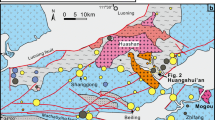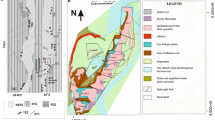Abstract
The Alnö alkaline-carbonatite complex consists in its northernmost part at Laångarsholmen of a ring-type intrusion composed of pyroxenite, sövite and ijolite, emplaced in that order. The intrusion is surrounded by a breccia zone. The petrography, mineral chemistry and fluid/solid inclusion studies suggest that the ring complex and the main intrusion at Alnö have had a somewhat different magmatic evolution, implying different evolution of fluid phases also. At Laångarsholmen, a mafic silicate magma started to crystallize Al-diopside of 0.11 CaTs (Tschermak’s) content during a mid-crustal stage of evolution (ca. 5–6 kbar and 1175° C). At that stage, the mafic magma was coexisting with a Mg-bearing calcitic melt, recorded in the abundant inclusions, trapped by the crystallizing Al-diopside. The two immiscible melts appear to have separated at ca. 5 kbar and 1150° C, in good agreement with recent experimental studies. The silicate magma crystallized di+ap+magnetite during its ascent, and was in contact with a saline hydro-carbonic fluid trapped as inclusions in diopside (di) and apatite (ap) (type B2 inclusions reluctant to dissolution up to 550° C). As PH2O started to increase, Fe-pargasite began to replace the pyroxene. It appears that the fluid present at that stage was aqueous and contained ca. 40% NaCl. With decreasing PT, the fluid separated into two immiscible phases of high- and low-salinity (type B1 of 65% NaCl and Cl of 7% NaCl), respectively. At the shallow depths of the final emplacement, the composition of the fluid phase was most probably controlled by supply of meteoric water as indicated by the dilution trend of some B1 type inclusions. After separation, the carbonatite magma fractionated calcite+ap+dol (as shown by dolomite inclusions in early crystallizing apatite). Around 4 kbar, a CO2-bearing aqueous fluid of low salinity (d=0.85) was coexisting with the melt, and became trapped in the apatite formed during the mid-crustal stage (type A1 fluid inclusions). The residual melt was emplaced into the shallow crust and gave rise to phlogopite-bearing sövite. Fluid inclusions (type A2) trapped in calcite and in recrystallized apatite indicate that the fluid phase evolved towards a late (Na+K) hydro-carbonic fluid during cooling at the shallow depths of the final emplacement. The ijolite does not show signs of liquid immiscibility with the sövite at Laångarsholmen, and exhibits mostly post-magmatic activity of fluid phases.
Similar content being viewed by others
Author information
Authors and Affiliations
Additional information
Received: 15 September 1994 / Accepted 25 July 1995
Rights and permissions
About this article
Cite this article
Morogan, V., Lindblom, S. Volatiles associated with the alkaline – carbonatite magmatism at Alnö, Sweden: a study of fluid and solid inclusions in minerals from the Laångarsholmen ring complex. Contrib Mineral Petrol 122, 262–274 (1995). https://doi.org/10.1007/s004100050126
Issue Date:
DOI: https://doi.org/10.1007/s004100050126




